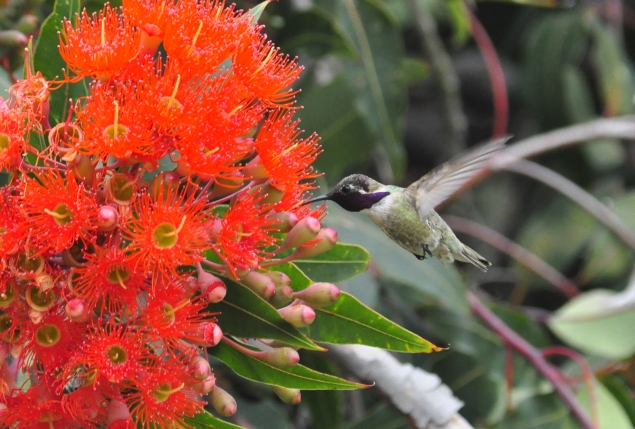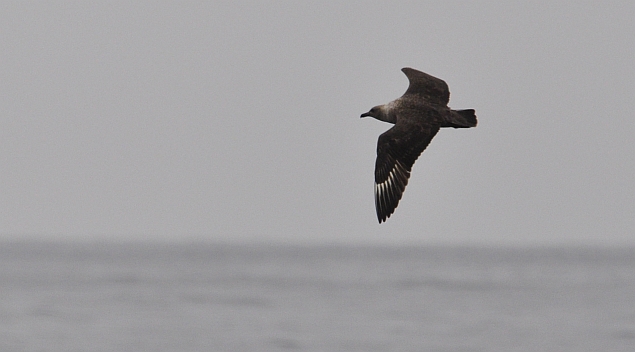This is a Xantus' Murrelet family. Ain't they cute? They were born in the Coronado Islands in Mexico, and immigrated to U.S. waters to forage. No one on board the boat expressed an urge to deport them, despite them depleting our precious resources.
I went on a well-attended pelagic trip over the weekend out of San Diego. Birds were often in low numbers, and so we were forced to pay attention to marine mammals, or worse, birders themselves. It made for an entertaining day, considering I knew a lot of people on the boat.
Anyone who has been on a pelagic knows that people invariably end up seasick or passed out, or both. I passed out in some random person's chair for an hour (thanks!), waking only to see the one and only Pomarine Jaeger of the day fly by (nice spoons!). The seasickness is self explanatory, the sleepiness a biproduct of various motion-sickness remedies and getting up insanely early in the morning. A European girl barfed a lot. One dude (a leader) was sleeping all over the back of the boat, and ended up using one of the giant bags of chum popcorn as a pillow. He was ridiculed mercilessly but took it in stride (meaning he was asleep for most of it).
Some people hardly moved at all, the entire time, and I don't think they were even seasick. I fail to see why you would bother to even go on a bird boat if you are not interested in seeing birds. There were some impressive feats of laziness. Maybe some people just really like to have lots of strangers look at them sleep...a strange fetish, but who am I to judge?
In U.S. waters, Black Storm-Petrels are confined to California (as are the murrelets above). Luckily they were with the boat regularly throughout the day, and a few swooped in close enough for photographs.
A friend who will remain safely anonymous provided great entertainment by loudly pointing attention to certain birds and blatantly misidentifying them. This deserves further discussion....let us refer to him, from now on, as Red Phalarope Man.
For one, people (non-leaders) really should be calling out birds. You will frequently find yourself getting on interesting-looking birds before the leaders do, so you should point them out, no question about it, even if you're not sure what they are. Good examples of this would be "a black and white shearwater" or "a storm-petrel with a white rump". The problem arises when you completely slaughter an identification. That is when the shame and embarrassment sinks deep into the marrow of your bones, and you feel like you are rotting from the inside out, particularly when you appear to be stringing a common bird into a rarer one.
Relatively early in the day Red Phalarope Man called out a Northern Fulmar, which quickly morphed back into a Sooty Shearwater. I could understand how that Sooty Shearwater may have looked like a fulmar...it was in heavy molt, and flying directly away. In fact, I have made that same mistake on a boat....but corrected myself, of course. Not this time...it took a phlanx of other birders, including a leader, to coax this confused Red Phalarope Man down from his fulmarrish high. Still, this innocent act is quite forgivable, at least on its own.
Red-necked Phalaropes. They are not similar to Red Phalaropes, particularly in the middle of May.
Later in the day, someone spotted a very distant flock of phalaropes sitting on the water in horrible light. Not realizing that they were impossible to identify at such a distance, a phalarope-crazed birder exclaimed, "What are they?!
What kind of phalaropes?!" The appropriate reaction to such an outburst would be awkward silence, so I was shocked to hear Red Phalarope Man exclaim loudly, to the whole boat, "RED PHALAROPES! RED PHALAROPES!"
This confused me. I had previously trusted Red Phalarope Man's identification skills. He is (was?) a friend of mine. Being the Number 7 birder in the nation, it was clear to me immediately that this was a baseless claim, even though it was possible he was correct. We had seen many Red-necked Phalaropes that day, but no Reds. The distance between us and the birds was staggering. The only thing that was discernible about these fantastically far birds was a sort of grayish tint, and that itself bordered on a hallucination. And although I wanted him to be right, I was utterly unsurprised when we motored up to the flock and they were all Red-necked Phalaropes, the commoner and less facemelty species.
When the true identify of the flock became known, the fallen birder had slunk from the bow of the ship, avoiding eye contact at all costs. He did not appear again until many hours later, and it was obvious to everyone that the light had gone out of his eyes. His cheeks were stained with dry tears, and he walked as if he was heavily burdened. Of course, other birders smelled the blood in the water, and Red Phalarope Man was mercilessly chastised throughout the rest of the trip for his very public lapse in judgement. It was relentless, and is probably what kept our sanity for the rest of the day, because we hardly saw anything else in the way of birds. Feeling backed into a corner, he even claimed that I had no right to talk shit because I wasn't calling out birds! That son of a bitch! I had been calling out birds like there was no tomorrow (all correctly, thanks)...it was a true stab in the back, and I do not intend to ever forgive this amateur birdwatcher for his treachery.
In reality (where nonbirders live), we were just taking the piss out of him, and we all raged together happily at the end of the day. The primary leader of the trip botched a few calls himself...they say shit happens, but so do blown calls. Red Phalarope Man did correctly identify a giant bail of marijuana floating in the water, and why we passed by hundreds of thousands of dollars bobbing around in the sea was a mystery to him.
Pink-footed Shearwaters were one of the few common species offshore. The economy of style reigns supreme in these waters.
This South Polar Skua was the only major highlight of the day. It spent a lot of time closely circling the boat, triggering a number of strokes among the more sensitive birders. I've never seen one this early in the year before, and never such a curious one....so not a bad bird, by any means. Many more photos of this penguin-slayer to come.
Phalaropes were the basis of another humorous moment, when possibly the same phalarope-crazed woman from earlier was demanding the identity of another incredibly distant phalarope flock. "Can someone tell what they are?", she pleaded. "Isn't there a leader nearby to tell us? WHERE IS A LEADER?"
Of course, a leader happened to be standing right next to her, and for his own reasons thought it best to completely ignore her, for good or ill. I do not condemn this act, although its not exactly good business...I eventually stepped in and kept it real with her.
And so it goes. Another day on the boat. I seem to be developing an unlucky boat streak....my last really good day at sea was back in 2010, when I finished finished the afternoon with hundreds of Short-tailed Shearwaters, dozens of Laysan Albatross, a Short-tailed Albatross, and friendly flocks of Horned and Tufted Puffins as we pulled into the harbor....of course, I was getting paid to see all of that, but that was another time.
Elegant Terns frequently bummed out the boat by suddenly appearing overhead far out at sea. Normally this would not be an unfortunate event, but most people were hoping for Common and Arctic Terns instead. They are still great though.
Sooty Shearwater; a bird unlike a Northern Fulmar.



























































